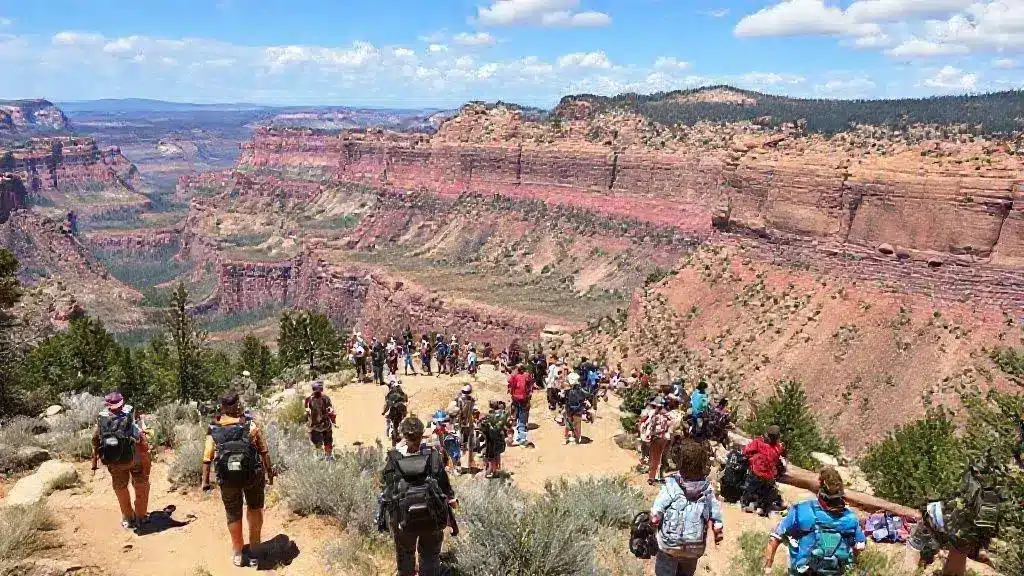National Park Visitor Surges: What You Need to Know

National Park visitor surges increase economic benefits for local communities but pose challenges for park management, necessitating sustainable practices and technology to enhance visitor experiences while preserving natural resources.
National Park visitor surges have become a trending topic due to the growing popularity of outdoor spaces. With more individuals seeking nature’s solace, how can we make the most of our visits while ensuring the parks remain pristine?
Understanding the reasons behind visitor surges
Understanding the reasons behind visitor surges in national parks is essential for both tourists and park management. Recently, more people have sought outdoor experiences, which can lead to crowded parks and increased pressure on park facilities.
There are several factors that contribute to this growing trend. Each year, parks see spikes during weekends and holidays. As the weather gets warmer, families and adventurers flock to popular destinations. This surge in visitors can sometimes be overwhelming for both guests and the park infrastructure.
Key Factors Influencing Visitor Surges
The following are some key reasons driving the increase in visitors:
- Increased interest in outdoor activities, particularly post-pandemic.
- Social media promoting beautiful park landscapes.
- A rise in travel budgets for families seeking accessible vacations.
- Enhanced park facilities and services attracting more people.
Furthermore, events like guided hikes or special park anniversaries can also boost attendance. These activities create excitement and encourage more visitors to explore.
Another significant influence is the role of technology. With mobile apps providing information on trails, wildlife sightings, and park events, people are more informed and motivated to visit. The ease of access to this information can result in higher numbers of visitors at popular times.
The Role of Social Media
It’s worth noting how social media platforms showcase national parks. Posts of breathtaking landscapes encourage friends and family to visit similar locations. This digital exposure can lead to a surge as people want to experience these beautiful parks firsthand.
In summary, various factors, from seasonal changes to social media influence, contribute to the peaks in national park visitor surges. Understanding these patterns helps everyone prepare better for what to expect during visits.
Impact of surges on park resources
The impact of surges on park resources is significant and multifaceted. As visitor numbers increase, the strain on these natural environments becomes more pronounced. Parks must balance providing access to visitors while preserving the integrity of their ecosystems.
High visitor counts can lead to overcrowded trails, which not only affects the hiking experience but can also damage sensitive plant life and disturb wildlife habitats. When trails become worn, erosion occurs, leading to further degradation of the landscape. This cycle can have long-lasting effects on park health.
Resource Management Challenges
Park management faces several key challenges when handling visitor surges:
- Maintaining trails and facilities to accommodate larger crowds.
- Protecting wildlife from increased human interaction.
- Addressing litter and waste management to keep parks clean.
- Ensuring safety and accessibility for all visitors.
Park rangers and staff often find themselves working overtime during high traffic periods. This can stretch resources thin, impacting the quality of service. Moreover, ensuring that educational programs continue runs into challenges as staff focus on immediate visitor needs.
Additionally, increased foot traffic can disrupt animal migration patterns and lead to a rise in human-wildlife conflicts. As animals get used to human presence, they may become less cautious, which can result in dangerous situations.
Environmental Consequences
With rising visitor levels, parks are experiencing greater environmental consequences as well. The following effects are often noticed:
- Soil compaction and damage to vegetation.
- Water pollution from runoff and litter.
- Increased risk of forest fires due to carelessness with campfires.
- Loss of biodiversity as habitats are compromised.
Ultimately, understanding these impacts allows us to appreciate the importance of sustainable tourism practices. When visitors are aware of their effects, they can help preserve the parks for future generations.
Tips for visitors during peak times

During peak times, national parks can become crowded, making it important for visitors to be prepared. Having a plan can help you enjoy your experience while avoiding common pitfalls. Here are some effective tips that can make your visit smoother and more enjoyable.
Plan Your Visit Wisely
Consider visiting during weekdays or early mornings to avoid large crowds. Parks are less busy right after opening or later in the afternoon. This allows for a more peaceful exploration of nature.
- Use park websites or apps for real-time updates on visitor numbers.
- Check for any scheduled events that might attract larger crowds.
- Avoid holidays and school vacation periods when possible.
On your visit, it’s also wise to choose less popular trails. There are usually many hidden gems that offer beautiful scenery without the crowds. These less-trodden paths provide a chance to connect with nature more intimately.
Pack Smart and Be Prepared
Always pack essential items such as water, snacks, and sunscreen. Having these basics can help you feel comfortable while exploring. Also, bring a map or download a navigational app to help you stay oriented in the park.
- Wear comfortable shoes suitable for hiking.
- Bring a backpack to carry your supplies easily.
- Consider a camera for capturing your memories without the rush.
Staying safe and hydrated is crucial as well. The more prepared you are, the more you can enjoy your time.
Respect Nature and Park Rules
Being mindful of park rules helps protect both the environment and your experience. Always follow guidelines, stay on marked trails, and carry out what you bring in. This ensures parks remain enjoyable for everyone.
In addition, remember to keep noise levels down. Being respectful of wildlife and other visitors enhances everyone’s experience.
By keeping these tips for visitors during peak times in mind, you can navigate the busy atmosphere of national parks with greater ease and enjoyment. Your thoughtful actions help maintain these beautiful spaces for future generations.
Local community response to increased visitors
The response of local communities to increased visitors in national parks plays a crucial role in the overall visitor experience. As parks attract more tourists, neighboring towns and residents often experience both benefits and challenges.
Many communities welcome the influx of visitors due to the economic boost it brings. Local businesses, such as hotels, restaurants, and shops, benefit significantly from park visitors. More foot traffic leads to increased sales, which helps the area’s economy thrive. Along with this, events and festivals tailored to tourists can enhance community engagement and provide entertainment.
Challenges Faced by Local Communities
However, a rise in tourism can also bring about several challenges for local residents:
- Increased traffic congestion can disrupt daily life.
- Higher demand for public services and resources.
- Potential strain on local infrastructure.
- Environmental concerns due to increased waste and pollution.
Communities work hard to address these issues while also ensuring visitors receive a positive experience. This can involve public meetings to discuss visitor impacts and collaborative efforts with park management to create effective solutions.
Collaboration with Park Officials
Partnerships between local governments and park officials are vital to minimizing the negative impacts of increased visitation. Together, they can implement strategies like shuttle services to reduce traffic, promote sustainable practices, and improve amenities. Regular communication creates a network of support that benefits both residents and visitors.
By sharing resources and knowledge, local communities can work towards creating a balance where tourism enhances their livelihoods while preserving the natural beauty that draws people to the area.
Understanding the local community’s response to increased visitors is essential for anyone planning to visit a national park. Engaging with locals can enhance your experience and support the sustainability of these beautiful regions.
Future trends for national parks and tourism
The future of national parks and tourism is evolving as society changes. With growing interest in outdoor activities, parks are adapting to meet new visitor expectations while maintaining their natural beauty.
One major trend is the increasing use of technology to enhance visitor experiences. Digital tools help people plan their trips, navigate trails, and learn about the environment. Apps that provide real-time updates about park conditions and crowds are becoming more common. This technology not only makes visiting easier but also encourages more people to explore.
Focus on Sustainability
Another significant trend is the emphasis on sustainability. National parks are adopting eco-friendly practices to minimize human impact on the environment. Initiatives may include:
- Implementing Leave No Trace principles.
- Encouraging the use of public transport or shuttles.
- Developing programs to reduce waste and increase recycling.
- Educating visitors about conservation efforts.
Sustainable tourism practices are essential as they help preserve the parks for future generations.
Changing Visitor Demographics
The demographics of visitors are also shifting. Parks are seeing more diverse groups, including younger visitors and families. This diversity leads to the demand for more inclusive activities and educational programs that cater to varied interests. Parks are beginning to provide a range of experiences, from adventure sports to family-friendly events.
Additionally, special focus is being given to making parks more accessible. This means finding ways to accommodate people with disabilities and their unique needs. Offering adaptive equipment and accessible trails can help ensure everyone enjoys the beauty of nature.
In summary, as we look to the future, national parks are poised to adapt to changing visitor needs while promoting sustainability. By implementing new technologies and embracing diversity, these beautiful landscapes will continue to thrive.
FAQ – Frequently Asked Questions about National Parks and Tourism
How are national parks adapting to the rising number of visitors?
National parks are using technology to enhance visitor experiences, promoting sustainability, and creating more inclusive programs to accommodate diverse visitors.
What role does technology play in improving national park visits?
Technology, including apps for navigation and real-time updates on conditions, helps visitors plan their trips and enhances their overall experience.
Why is sustainability important for national parks?
Sustainability practices help minimize the environmental impact of tourism, preserving natural resources for future generations while ensuring a positive visitor experience.
How can local communities benefit from increased park tourism?
Local communities gain economic benefits through increased business from visitors, but they also collaborate with park officials to address challenges and maintain quality of life.





